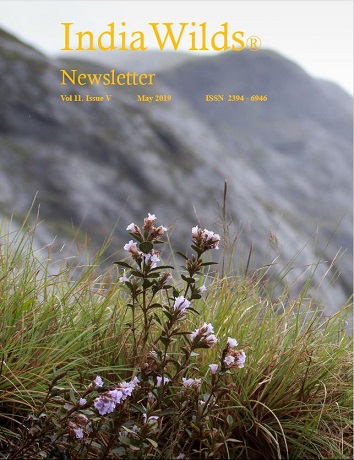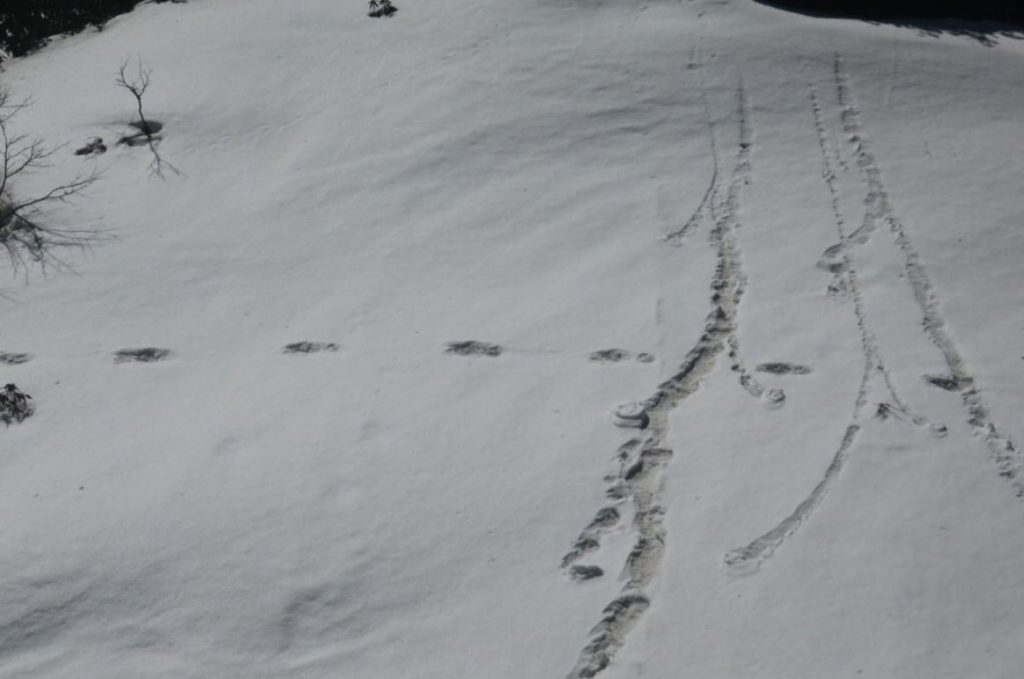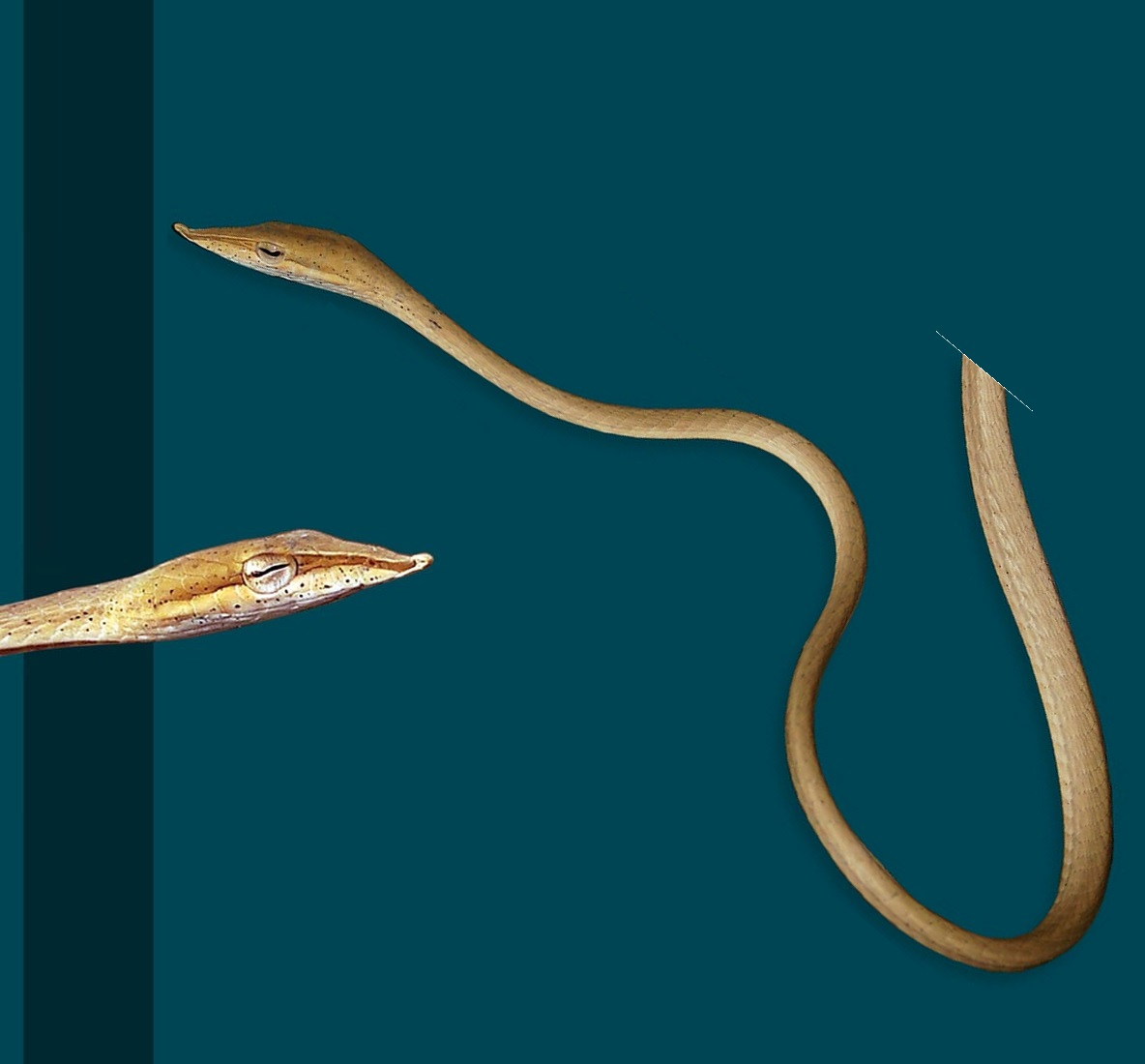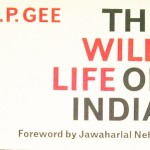IndiaWilds Newsletter Vol. 11 Issue V
ISSN 2394 – 6946
A Wake up Call from Yeti
Indian Army expedition team found mysterious marks in snow in the Makalu-Barun National Park. These marks were 32 inch long and 15 inch wide. The Indian Army said that they sighted these marks on 9th April close to the base camp. The army believed that these mysterious marks were the footprints of the mythical Yeti.
The Indian army shared a set of photos and said that these marks formed a trail about a kilometre or more. Since these photos were shared by the official twitter handle of the Army, many people believed that it is possible that the army expedition team may have indeed found physical evidence of Yeti, the mythical snowman.
Many of us have read stories of the mythical Yeti while growing up in India. People abroad too have been fed with a diet of Yeti stories. The comic book “ Tintin in Tibet” also had a story about Yeti. So there is considerable interest about Yeti. It is another matter that Yeti has been described as “abominable snowman”. Why someone wants to use the word abominable for a species is difficult to understand. Perhaps, it is our fear of the unknown which results in such nomenclature.
Some believe Yeti is half-man and half bear. Some say Himalayan brown bear is often mistaken as Yeti. Some passionate believers believe that there is always a possibility of a large biped creature existing hidden from us as we don’t stay in those rarefied heights of the Himalayas. They argue that the Yeti may be a hominid, some kind of descendant of Denisovans who were much larger than humans and believed to have been extinct some 40,000 years ago. Don’t we know that the Himalayas is such a huge area and few such creatures could have been existing without we knowing is the common refrain? It is another matter that these days all animal species know about the destructive hand of man and prefer to hide.
The photos shared by the Indian army showed one single line of impressions or “tracks”. The melting snow results in the marks becoming indistinct. Overlapping marks can also appear later as one single large mark. While the Indian Army said that they will handover all photos for experts to take a call on it, without any direct photo of a creature with hair or other samples for DNA verification, it remains as yet another claim.
Nevertheless, this Yeti controversy shows how little we know about the world in which we inhabit. Also whether we believe in Yeti or not, if we need to give future generations a chance to discover a species, then we need to allow the habitat to remain as it is.
For the first time, an #IndianArmy Moutaineering Expedition Team has sited Mysterious Footprints of mythical beast 'Yeti' measuring 32×15 inches close to Makalu Base Camp on 09 April 2019. This elusive snowman has only been sighted at Makalu-Barun National Park in the past. pic.twitter.com/AMD4MYIgV7
— ADG PI – INDIAN ARMY (@adgpi) April 29, 2019
Protect Himalayan Glaciers:
The Himalayan region consists of large number of glaciers and covers an area of 33,000 sq. km. The Himalaya is a lifeline of our country. Apart from helping in the rains, the glaciers there are origin to many of our rivers. Various reports suggest that the health of the Himalayan glaciers is not well.
Climate change is for real. It would be naïve to assume that Himalayan glaciers will remain unaffected when the entire world is witnessing unpredictable extreme climatic events and the mean temperature of our cities are increasing. So the Himalayan glaciers are also melting. A study “Retreating rate of Chaturangi glacier, Garhwal Himalaya, India derived from kinematic GPS survey and satellite data” (Bisht et al, Current Science Vol. 116, No. 2, Jan 2019) used Kinematic GPS to find out that snout has Chaturangi Glacier snout has retreated 1172.57 ± 38.3 m (average = 45.07 ± 4.31 m/year) with a total area and volume loss of 0.626 ± 0.001 sq. km and 0.139 km3.
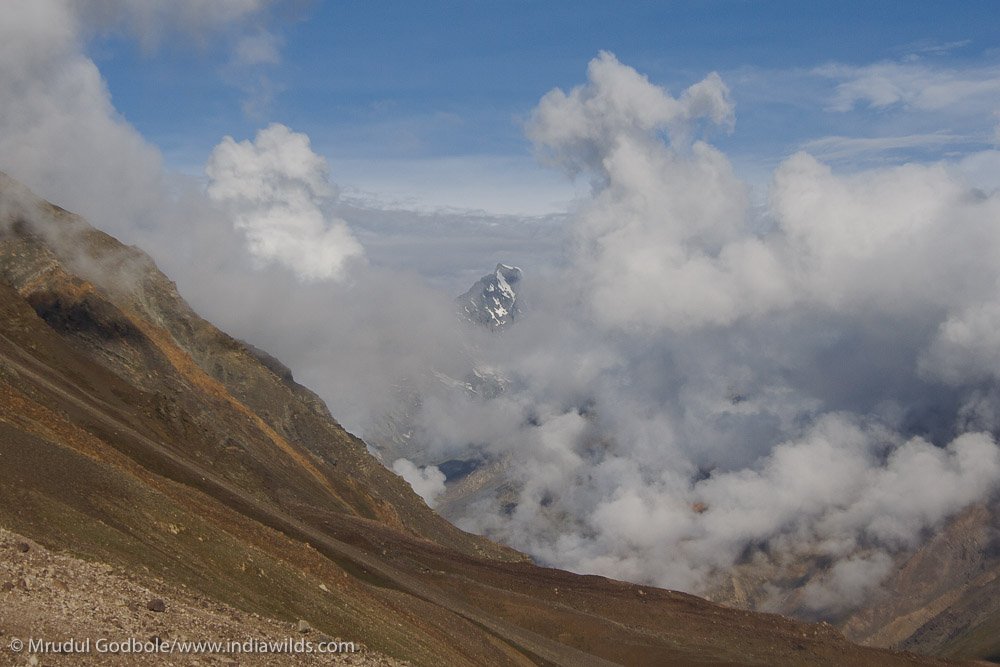
Clouds covering snow capped peaks in the high altitude barren landscape of Ladakh in India. This is at a height of 15000 feet.
A study on the Satluj basin, which has 2026 glaciers over 1426 square kilometres, found that 55% of glaciers may vanish by 2050 and 97% by 2090. This would have a massive impact on us as the various irrigation and power projects will be hit. During this doomsday scenario, India would be already the most populated country on earth. History is replete with stories of rise and fall of civilisations due to rivers changing their course or lack of water due to draught.
Scientists believe that the Harappa civilisation declined and people migrated out of it due to monsoons failing continuously for 200 years. This finding was based the study of Oxygen 18 versus Oxygen 16 isotope in the snail shells in Kotla Dahar. In a path breaking study, published in Geology (Abrupt weakening of the summer monsoon in northwest India 4100 yr ago, Y. Dixit, Geology, 2014) palaeoclimatologist Yama Dixit and team found out that between 4000 and 4200 years ago, the annual monsoon rains had stopped for a continuous period of two hundred years. (http://www.indiawilds.com/diary/indiawilds-newsletter-vol-6-issue-iii/ )
Our earth has seen various climatic conditions and extinctions of species due to changes in the climate. If meticulously planned city like Harappa can be wiped away due to vagaries of climate, shouldn’t we be concerned?
One major aspect is often missed out while discussing the impact of glacier melting. In Yamal Peninsula, Siberia in the summer of 2016 the heatwave resulted in melting of the ice and a reindeer carcass got exposed. This reindeer had died due to anthrax. The anthrax got into water and soil and other reindeers got infected. A 12 year old boy died after contracting it and another 90 people were hospitalised in August 2016. (BBC News, Aug 2016, https://www.bbc.com/news/world-europe-36951542)
In Siberia the melting permafrost also unearthed a virus (Pithovirus sibericum) which is thirty thousand year old distant relative of giant icosahedral DNA viruses with morphology of pandoravirus. And alarmingly even after the passage of 30,000 years the virus had retained its ability to infect. This shows that when the ice cover melts, there are chances of many such distant viruses coming to life. The movie “Mummy returns” will sound allegoric with all the ghosts and spirits being replaced by the various viruses buried for thousands of years and even for millenniums. We the modern human beings have lost our ability to face such viruses.
The earth has seen many species extinctions. Unwittingly we the humans may be triggering our own demise, one way or other, through our actions. Unless we wake up to the reality now, it may be too late for us to reverse our actions.
Way Forward:
The Climate crisis needs to be tackled at a war footing. There are various corporates who are trying to peddle technological solutions to fight the climate crisis. This is akin to a house on fire and its inmates bartering deals with each other regarding their roles in firefighting.
This attitude would help the corporates and their countries to benefit from the climate crisis. However it is not likely to be successful.
When the planet earth is facing a climate cauldron there are simple solutions to fight and stop this crisis. Tom Crowther, climate change ecologist at ETH Zurich has found that if the amount of carbon that can be fixed if we plant 1.2 trillion trees and allow those to grow will be far higher than any other climate change solution. He has found that there are 3 trillion trees on earth and there is room for an additional 1.2 trillion trees. So definitely this is a feasible solution.
However, one needs to be careful about it because when we inform volunteers to plant trees, they may just go and plant non-native trees which damage the ecosystem. Or they may plant trees in grasslands and marshes which are important ecosystems and shouldn’t be messed with. At present the Government of India has tweaked the definition of forests and all commercial plantations are included in it. Given the pulls and pressures from the corporate lobby one can expect that exotic species like eucalyptus which are used for pulp as well as for firewood purpose will get planted. The 1.2 trillion plan will only succeed if trees are allowed to grow into giant old hardgrowth trees so that their carbon sequestration potential is maximised.
The country needs to start the 1.2 trillion tree plantation in a mission mode. Much of India’s forests, grasslands, revenue lands etc are overrun with the exotic weed lantana. Removal of this exotic weed will help save the country millions of dollars. Pasteur losses due to lanatana has been estimated at $924 million dollars and the crop losses from weeds ( the majority of which is lantana) amounts to a humungous $37.8 billion dollars. (http://www.indiawilds.com/diary/indiawilds-newsletter-vol-7-issue-vii/comment-page-1/)
So the country can plan to remove lantana and plant species native to that area. Care should be taken in this because India is a vast landmass and the climate varies from place to place. Accordingly the vegetation also varies. So care should be taken to plant trees that are native to the area.
Generally we focus on tree plantation. However, large dams, mines, canals, roads and other infrastructure projects result in massive diversion of forest area. In the last three years, between 2015-2018, the Government of India has diverted 20314 hectares of forest land. This amounts to forests size of Kolkata being razed down. We have to first clamp down on all such diversion of forests and other areas so that hard growth trees doesn’t get cut down. Unfortunately, given the track record of the Government, diversion of forests and cutting down of old hard growth trees is bound to happen, perhaps in an even bigger scale than before. This is akin to raising kids while killing all able-bodied adult men and women. Will a country progress in such a situation? So again we are back to square one.
Whether Planet Earth will remain a habitable place for humans or not is to be decided by the political class. There have been wave of protests worldwide to help save the Planet Earth. However, till date whatever we have seen doesn’t inspire much hope. Nevertheless we have to continue the good fight till the last moment. May be the leaders come back to their senses in time? As an eternal optimist, I continue to believe in miracles.
In Danger: Natural & Cultural Heritage of Brihaspati Kund
– By D.P. Srivastava
Brihaspati Kund is situated 40 kms away from the Panna city, on the way to Kalinjar Fort. The area is part of northern Vindhya Ranges which is one of oldest hill ranges in country extended from Gujrat to Uttar Pradesh from the center of Indian subcontinent. Many historians suggest that this area is one of the few regions of India, which is a treasure trove of archaeological wealth as it is witness to various human habitations since prehistoric age. In Indian mythology, Brihaspati Kund is named after Guru Brihaspati (Religious teacher of Gods). It is believed that Guru Brihaspati had founded an ashram and performed his Yagyas to please God and Goddesses. Pleased with his penance, the Gods blessed the area with wealth. Since then diamond has been found in this landscape. According to another myth, Lord Rama also visited the area to meet Rishis during exile period.
For more details click below –
Conservation News:
‘Not all animals migrate by choice’ campaign launched to raise awareness on illegal wildlife trade
Ahead of the International Day of Biological Diversity celebrated on May 22, UN Environment India and Wildlife Crime Control Bureau (WCCB) of India launched an awareness campaign ‘Not all animals migrate by choice’ to be displayed at major airports across the country.
Illegal wildlife trade is driving species to the brink of extinction. A thriving industry with organized wildlife crime chains spreading across the world, in India, illegal trade in wildlife has seen a sharp rise. The campaign ‘Not all animals migrate by choice’ aims at creating awareness and garnering public support for the protection and conservation of wildlife, prevention of smuggling and reduction in demand for wildlife products. The campaign also complements worldwide action on illegal trade in wildlife through UN Environment’s global campaign, Wild for Life.
Recent media reports on seizures of illegally traded species and their parts at airports is a growing indication of rampant wildlife trafficking. Some of the major wildlife species being smuggled through airports are star tortoises, live birds, Shahtoosh shawls, tiger and leopard body parts, ivory, rhino horns, pangolin and pangolin scales, sea shells, sea-horse, Sea-cucumber, red sanders, agarwood, deer antlers, mongoose hairs, reptile skins, live snakes, lizards, corals, orchids and medicinal plants.
Actor, Producer, UN Environment Goodwill Ambassador and recently appointed Secretary-General’s SDG Advocate, Dia Mirza inaugurated the campaign.
Dia Mirza, Actor, Producer, UN Environment Goodwill Ambassador & Secretary-General’s SDG Advocate inaugurated the campaign and said, “Wildlife trafficking thrives on ignorance and indifference to the species and laws that govern it .This campaign gives a glimpse of the cruelty and suffering these magnificent species have to endure for being trafficked. The need of the hour is greater awareness and commitment to protecting these species to ensure that they not just survive but also thrive in the wild.”
Speaking on the occasion, Secretary, Ministry of Environment, Forest and Climate Change, Shri CK Mishra said “Conservation is innate to India’s ethos. While wildlife faces threat across the globe and India’s flora and fauna’s demand continues in illegal global markets, in keeping with our stringent provisions for protection of wildlife under the Wild life (Protection) Act, 1972, efforts towards creating awareness among public at large would go a long way to help protect our wildlife”.
“There is an urgent need for awareness, action and stringent enforcement of laws to put an end to all illegal wildlife trade threatening biodiversity and conservation in the wild. This campaign is an important step forward in creating much-needed awareness on wildlife trafficking which threatens the very survival of these species,” said Atul Bagai, Head, UN Environment India.
“A huge global demand for our flora and fauna is a major cause for illegal wildlife trade by ruthless cross border smugglers. WCCB stands committed to fight this organized crime but it is crucial to work together across various government and non-government organizations, private sector and civil society to save wildlife. Our awareness campaign at Airports is a step towards reaching out to the public,” said Tilotama Varma, Additional Director, Wildlife Crime Control Bureau of India
In collaboration with the Airports Authority of India and GMR Group, the campaign will travel across 22 airports across India over the next year. Both WCCB and UN Environment initiated a comprehensive approach with a focus on awareness building of various stakeholders towards the issue of prevention of illegal trade and smuggling of wildlife and wildlife products through exit points. The awareness campaign is expected to complement the efforts of the Govt. Agencies.
UN Environment is the leading global voice on the environment. It provides leadership and encourages partnership in caring for the environment by inspiring, informing, and enabling nations and peoples to improve their quality of life without compromising that of future generations. UN Environment works with governments, the private sector, the civil society and with other UN entities and international organizations across the world.
Wildlife Crime Control Bureau is a statutory multi-disciplinary body established by the Government of India under the Ministry of Environment and Forests, to combat organized wildlife crime in the country.. Under Section 38 (Z) of the Wild Life (Protection) Act, 1972, it is mandated to collect and collate intelligence related to organized wildlife crime activities and to disseminate the same to State and other enforcement agencies for immediate action so as to apprehend the criminals; to establish a centralized wildlife crime data bank; co-ordinate actions by various agencies in connection with the enforcement of the provisions of the Act; assist foreign authorities and international organization concerned to facilitate co-ordination and universal action for wildlife crime control; capacity building of the wildlife crime enforcement agencies for scientific and professional investigation into wildlife crimes and assist State Governments to ensure success in prosecutions related to wildlife crimes; and advise the Government of India on issues relating to wildlife crimes having national and international ramifications, relevant policy and laws. It also assists and advises the Customs authorities in inspection of the consignments of flora & fauna as per the provisions of Wild Life Protection Act, CITES and EXIM Policy governing such an item.
COP meetings of Basel, Rotterdam and Stockholm conventions held in Geneva.
The joint meetings of three conventions on chemicals and waste that is the fourteenth meeting of the Conference of the Parties (COP) to Basel Convention on the Control of Transboundary Movement of Hazardous Wastes and their Disposal (COP 14) was held along with the ninth meeting of the COP to Rotterdam Convention on the Prior Informed Consent Procedure for Certain Hazardous Chemicals and Pesticides in International Trade and the ninth meeting of the COP to Stockholm Convention on Persistent Organic Pollutants. These meetings were held in Geneva from 29th April to 10th May 2019. The theme of the meetings was “Clean Planet, Healthy People: Sound Management of Chemicals and Waste”.
In Basel Convention, two important issues were discussed and decided, i.e. technical guidelines on e-waste and inclusion of plastic waste in the PIC procedure. The draft technical guidelines stipulated the conditions when used electrical and electronic equipment destined for direct reuse, repair, refurbishment or failure analysis should be considered as non-waste. India had major reservations regarding these provisions as in the name of re-use, repair, refurbishment and failure analysis there was a possibility of dumping from the developed world to the developing countries including India in view of the growing consumption of electronic equipment and waste across the world. The Indian delegation strongly objected the proposed decision on these guidelines during plenary and did not allow it to be passed by the conference of the parties (COP).
Many rounds of multilateral and bilateral negotiations happened under the aegis of the Convention Secretariat in order to address India’s concerns which were supported by a large number of other developing countries. On the final day of the COP, a modified decision was adopted in which all the concerns raised by India were incorporated.
These were: dumping of e-waste in developing countries; recognition that the interim guideline has issues and further work is required specially on the provision on distinguishing waste from non-waste; the guidelines were adopted on an interim basis only; the tenure of the expert working group was extended to address the concerns raised by India; and the usage of interim guidelines to be done only on a pilot basis.
Under the Basel Convention, another major achievement of COP 14 was the decision to amend the convention to include unsorted, mixed and contaminated plastic waste under PIC (Prior Informed Consent) procedure and improve the regulation of its transboundary movement. This is a significant step taken towards addressing plastic pollution which has become a major environmental concern across the globe.
Further, Basel Convention has also adopted partnership on plastic which was welcomed by the Indian delegation. These steps will help prevent the illegal dumping of plastic wastes in developing countries. India has already imposed a complete prohibition of import of solid plastic waste into the country. India has also made an international commitment to phase-out single-use plastic. India fully supported this exercise and one of the members of the Indian delegation was co-chair in the contact group which negotiated this agreement for amendment in the annexes of Basel Convention to bring plastic waste under PIC procedure.
Under the Stockholm Convention the COP decided to list “Dicofol” in Annex A without any exemption. The “PFOA” was also listed with some exemptions in the Annex A of the Stockholm Convention. Under the Rotterdam Convention, two new chemicals (Phorate and HBCD) were added in the list for mandatory PIC procedure in international trade.
Laudankia Vine snake discovered from Odisha
A new species of vine snake has been discovered from Odisha. Researchers from Centre for Ecological sciences, Indian Institute of Science, Wildlife Institute of India, Natural History Museum, London, Zoological Survey of India, Wayanad Wild have published their findings in Journal of Natural History (V. Deepak, Surya Narayanan, Vivek Sarkar, Sushil K. Dutta & Pratyush P. Mohapatra (2019) A new species of Ahaetulla Link, 1807 (Serpentes: Colubridae: Ahaetullinae) from India, Journal of Natural History, 53:9-10, 497-516, DOI: 10.1080/00222933.2019.1589591)
The study reportedly took 10 long years as the researchers found other samples in Boud and Balasore and compared with two more samples present in ZSI, which originated from Mount Abu in Rajasthan.
This discovery of a vine snake species has come after more than a century as the last discovery was in 1906. Out of the seven species of vine snakes in India, Odisha now has three species. Apart from the newly discovered laudankia, the other two vine snake species found in Odisha are the common Indian vine snake and the variable coloured vine snake. The researchers have proposed its standard English name as Laudankia vine snake. In Odia, lau means bottle gourd and danka means stem. The brown colour of the laudankia vine snake resembles the dried stem of bottlegourd. Its scientific name has been proposed as Ahaetulla laudankia.
In our childhood days we were told to be careful while plucking bottle gourd as there may be laudankia or vine snake in it. Personally I had believed it as myth. However, this discovery shows that some myths do have some element of truth in it. This discovery and the naming of the snake as laudankia has brought lot of joy to wildlife enthusiasts and herpetologists of Odisha.
Equipment Discussions:
All-new robust Olympus Tough TG-6 compact camera
Olympus Tough TG-6 delivers impressive image quality in an extremely rugged and compact housing.
Olympus has introduced Tough TG-6, a new flagship in their Tough compact camera series withstanding all weather conditions, underwater use, drop shocks and crushing weights.
Laowa has announced a new 100mm f2.8 Ultra Macro lens:
This is an interesting and slightly cheaper option for photographers shooting/filming macro subjects. Venus Optics Laowa has added a new lens to their macro lineup. Earlier it had launched the 60mm f2.8 2:1 macro lens. Now Laowa has added to its 2:1 macro lineup of lenses with the announcement of the 100mm f2.8 2:1 Ultra Macro APO lens for full frame cameras.
This lens has got 12 elements divided in 10 groups. The lens has 9 blade diaphragm which results in pleasing bokeh.
For more details click below link –
DJI Launches 4K Action camera Osmo
DJI has launched a 4K action camera for the first time to compete against the Go Pro Hero 7 which is selling extremely well.
Natural History
COUNTRY NOTEBOOK: M. Krishnan: ‘Shower Bath‘ shared By Saktipada Panigrahi
https://www.indiawilds.com/forums/showthread.php?8852-Country-notebook-m-krishnan&p=46208#post46208
Wildlife Photography
Desert Fox Pups by Vipin Sharma
https://www.indiawilds.com/forums/showthread.php?19148-Desert-fox-pups-LRK-diary-March-19
Deer in Bharatpur by Sabyasachi Patra
https://www.indiawilds.com/forums/showthread.php?19145-Pregnant-lady
Tiger by Shyamala Kumar
https://www.indiawilds.com/forums/showthread.php?19156-Son-of-Langadi
Tigress in Kabini by Jerin Dinesh
https://www.indiawilds.com/forums/showthread.php?19159-The-kabini-Backwater-lady
Robin by Mrudul Godbole
https://www.indiawilds.com/forums/showthread.php?19139
Rufous-throated Wren-babbler by Sandipan Ghosh
https://www.indiawilds.com/forums/showthread.php?19161-Elusive-Denizen-of-Eastern-Himalayas
Streak-Throated-Woodpecker by Murugan Anantharaman
https://www.indiawilds.com/forums/showthread.php?19152-Streak-Throated-Woodpecker
Lagerstroemia speciosa(Pride of india/Jarul) by Prajwal Ullal
https://www.indiawilds.com/forums/showthread.php?19147-The-pride-of-the-urban-streets
This is the 125th issue of IndiaWilds. The photo of Neelakurinji adorns the cover page of this issue. The Neelakurinji blooms every 12 years and had last bloomed in 2018. These mountains are the home of these flowering plants. If a modern day EIA (Environment impact assessment consultant) goes to this place, he will say that the land is barren or has some weeds and plants and recommend diversion of this place for some industry. The person will not know that once in 12 years this mountain landscape will be completely transformed with blooming of Neelakurinji plants.
Despite scientific studies we don’t know enough about our wild lands. The Yeti controversy as mentioned in the lead article in this issue as well as the discovery of a new species of Vine snake in Odisha shows that we should focus on the unknown mysterious species of plants, microbes, reptiles and smaller animals and their inter-relationships. And to discover new species their habitat has to be protected. So we have to focus on protecting our wilderness so that future generations have a chance to take pleasure watching nature’s miracles like the blooming of Neelakurinji and relaxing in those wild places as well as seek inspiration. Hope the new Government of India focuses on protecting our wild places for posterity.
I look forward to your inputs and support in preserving the last tracts of wilderness and wildlife left in our beautiful country and raising awareness about it. For other interesting articles and images check –
http://www.indi
To post in the IndiaWilds forums, you can register free of cost using your Full Name as user id at:
http://www.indiawilds.com/forums/register.php
If you are already a member of IndiaWilds and have forgotten your user id and/or password you can mail to:
administrator@indiawilds.com
If you want to contribute original articles, or for any image enquiries please send a mail to:
administrator@indiawilds.com
Regards,
Sabyasachi Patra
Profile | Contact Us | Facebook | Diary | Equipment reviews | Forums | IndiaWilds You Tube Channel
Please post your views and feedback in the comments below.
- GoPro Hero 12 Black - 6 September,2023
- Leopards: The Last Stand - 2 July,2023
- Drifting in the Waters of Sundarbans - 26 March,2023

